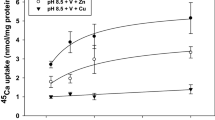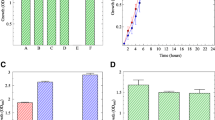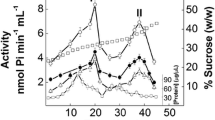Summary
-
1.
Labeled glycerol influx (J i G ) in the cestode,Hymenolepis diminuta, occurs by diffusion and two mediated systems which were distinguished by their sensitivity to Na+ and inhibitors. The Na+-activated system had a maximal glycerol influx (J i G max) of 91.5 μmoles/g ethanol extracted dry wt/hr and an apparent transport constant (K t ) of 0.24 mM; fluxes of glycerol and Na+ did not appear to be coupled. The second transport system, which operated in the absence of external Na+, had aJ i G max of 83.8 μmoles/g ethanol extracted dry wt/hr and aK t of 0.69 mM (Figs. 1 and 2).
-
2.
DL-β-glycerophosphate, glyceraldehyde, monoacetin, and phloretin inhibited both transport systems, while 1, 2-propanediol inhibited only the Na+-dependent system (Fig. 3).
-
3.
The inhibition ofJ i G by DL-β-glycerophosphate was relieved by ammonium molybdate, adenosine triphosphate, adenosine monophosphate and glucose-6-phosphate (Fig. 4, Table 1). These compounds had little or no effect onJ i G indicating that inhibition was produced by glycerol liberated from the hydrolysis of the phosphorylated compound by surface phosphohydrolases of the worm.
-
4.
Li+, K+, Tris and choline did not replace Na+ as an activator ofJ i G (Fig. 7). Glycerol diffusion rates in media where Li+ or K+ were used to replace Na+ were identical; however, replacement of Na+ with Tris lowered the diffusion rate (Table 2). Diffusion-corrected rates forJ i G were the same in Li+-, K+-, and Tris-substituted media, but were significantly lower in choline-substituted media; choline appeared to act as a competitive inhibitor of mediatedJ i G (Fig. 8, Table 2).
-
5.
Phloretin competitively inhibitedJ i G while phlorizin had no effect. The effects of pH on the inhibition by phloretin indicated that the ketonic form, and not the enolic form, of phloretin was responsible for inhibition (Fig. 5).
Similar content being viewed by others
References
Brand, T. von, Churchwell, F., Higgins, H.: Aerobic and anaerobic metabolism of larval and adultTaenia taeniaeformis. IV. Absorption of glycerol; relations between glycerol absorption and glucose absorption or leakage. Exp. Parasit.19, 110–123 (1966)
Brand, T. von, Gibbs, E.: Aerobic and anaerobic metabolism of larval and adultTaenia taeniaeformis. III. Influence of some cations on glucose uptake, glucose leakage, and tissue glucose. Proc. helminth. Soc. Wash.33, 1–4 (1966)
Crane, R. K., Forstner, G., Eicholz, A.: Studies on the mechanism of the intestinal absorption of sugars. X. An effect of Na+ concentration on the apparent Michaelis constants for intestinal sugar transport,in vitro. Biochim. biophys. Acta (Amst.)109, 467–477 (1965)
Dike, S. C., Read, C. P.: Tegumentary phosphohydrolases ofHymenolepis diminuta. J. Parasit.57, 81–87 (1971a)
Dike, S. C., Read, C. P.: Relation of tegumentary phosphohydrolase and sugar transport inHymenolepis diminuta. J. Parasit.57, 1251–1255 (1971b)
Dixon, M.: The determination of enzyme inhibitor constants. Biochem. J.55, 170–171 (1953)
Fisher, F. M., Jr., Read, C. P.: Transport of sugars in the tapewormCalliobothrium verticillatum. Biol. Bull.140, 46–62 (1971)
Goldner, A. M., Hajjar, J. J., Curran, P. F.: 2-Deoxyglucose transfer in rabbit intestine. Biochim. biophys. Acta (Amst.)173, 572–574 (1969)
Kipnis, D. M., Parrish, J. E.: Role of Na+ and K+ on sugar (2-deoxyglucose) and amino acid (α-aminoisobutyric acid) transport in striated muscle. Fed. Proc.24, 1051–1059 (1965)
LeFevre, P. G., Marshall, J. K.: Attachment of phloretin and analogues to human erythrocytes in connection with inhibition of sugar transport. J. biol. Chem.234, 3022–3026 (1959)
Lineweaver, H., Burke, D.: The determination of enzyme dissociation constants. J. Amer. chem. Soc.56, 658–666 (1934)
Nathans, D., Tapley, D. F., Ross, J. E.: Intestinal transport of amino acids studiedin vitro with L-131I-monoiodotyrosine. Biochim. biophys. Acta (Amst.)41, 271–282 (1960)
Pappas, P. W., Read, C. P.: Sodium and glucose fluxes across the brush border of a flatworm (Calliobothrium verticillatum, Cestoda). J. comp. Physiol.81, 215–228 (1972)
Pappas, P. W., Read, C. P.: Permeability and membrane transport in the larva ofTaenia crassiceps. Parasitology66, 33–42 (1973a)
Pappas, P. W., Read, C. P.: Relationship of surface phosphohydrolase activity and nucleoside transport inHymenolepis diminuta (Cestoda). J. Parasit. (submitted for publication) (1973b)
Pappas, P. W., Uglem, G. L., Read, C. P.: Mechanisms and specificity of amino acid transport inTaenia crassiceps larvae (Cestoda). Int. J. Parasit. (in press) (1973a)
Pappas, P. W., Uglem, G. L., Read, C. P.:Taenia crassiceps: Absorption of hexoses and partial characterization of Na+-dependent glucose absorption by larvae. Exp. Parasit.33, 127–137 (1973b)
Pappas, P. W., Uglem, G. L., Read, C. P.: Anion and cation requirements for glucose and amino acid accumulation byHymenolepis diminuta (Cestoda). Biol. Bull. (in press) (1974)
Phifer, K. O.: Permeation and membrane transport in animal parasites: On the mechanism of glucose uptake byHymenolepis diminuta. J. Parasit.46, 145–153 (1960)
Pittman, R. G., Fisher, F. M., Jr.: The membrane transport of glycerol byHymenolepis diminuta. J. Parasit.58, 742–749 (1972)
Pittman, R. G.: The membrane transport of glycerol byHymenolepis diminuta (Cestoda). Ph.D. thesis, Rice University, Houston, Texas (1972)
Read, C. P., Rothman, A. H., Simmons, J. E., Jr.: Studies on membrane transport, with special reference to parasite-host integration. Ann. N. Y. Acad. Sci.113, 154–205 (1963)
Schultz, S. G., Curran, P. F.: Coupled transport of sodium and organic solutes. Physiol. Rev.50, 637–718 (1970)
Woodward, C. K., Read, C. P.: Studies on membrane transport-VII. Transport of histidine through two distinct systems in the tapewormHymenolepis diminuta. Comp. Biochem. Physiol.30, 1161–1177 (1969)
Author information
Authors and Affiliations
Additional information
Supported in part by grant 5-TO1-AI-00106 from the National Institutes of Health, U.S. Public Health Service.
Rights and permissions
About this article
Cite this article
Uglem, G.L., Pappas, P.W. & Read, C.P. Na+-dependent and Na+-independent glycerol fluxes inHymenolepis diminuta (Cestoda). J Comp Physiol B 93, 157–171 (1974). https://doi.org/10.1007/BF00696270
Received:
Issue Date:
DOI: https://doi.org/10.1007/BF00696270




